Witches cauldron
Double, double, toil and trouble! Great for developing find motor skills and hand eye coordination while learning about an irreversible reaction and the history of Halloween.
Learning outcomes
You will be able to:
- Describe the reaction of dry ice with air and water.
- Provide an example of a substance that sublimates.
- Outline the origins and history of Halloween and describe how this has led to our current traditions (in an age appropriate way).
- Create some Halloween inspired poetry or spells.
You will need:
- 4 x Gratnells Art (A1) trays or 6 x Shallow black or orange Gratnells (F1) trays
- 1 x Deep Black Gratnells (F2) tray
- 4 x Cups of dry ice https://www.dryicesupply.co.uk/
- 10 x Cups of warm water (you may wish to colour your water for added drama or add a little glitter)
- 3 x Wooden spoons
- 3 x Plastic tweezers
- 1 x Bag of orange lentils
- 6 x Battery powered tea light candles
- An assortment of Halloween themed props and decorations, e.g. snakes, spiders, skeletons, black mice, black bats, orange and black mini pompoms, black and orange discs, counters or pebbles (from your maths manipulatives kit), mini-pumpkins or pumpkin shapes cut out of carrots.
- Video recording equipment (optional).
Preparation:
Take a look at our Witch’s Cauldron video here for inspiration and read the ‘’What is happening?’ section to learn about the history and origins of Halloween and the involvement of witches.
What to do:
- Lay out your trays as per the video, i.e. four large trays in a square with the black deep tray (the cauldron) on top, in the centre. You could vary this to suit the trays you have, i.e. use six standard shallow Gratnells (F1) trays as the base in place of the large art trays.
- Fill the large art trays with a scattering of the orange lentils and an assortment of Halloween themed props. You could get your observers to help you with this bit. What spooky ingredients can they find? Can they transfer them to the big trays using the spoons and the tweezers and spread them evenly around the four trays?
- Place a wooden spoon or pair of tweezers on the edge or next to each large tray.
- Gather round the cauldron in a big, seated circle on the floor. Be sure to keep a safe distance from the centre (~2m and well beyond arms reach).
- Set up your video recording equipment to capture the action (optional).
- Add 10 cups of warm water to the witch’s cauldron, you could get your observers to help you with this bit, with a different participant adding each cup full.
- Add 4 cups of dry ice to the warm water and stand back. The effect will be greater if you add all 4 cups worth at the same time.
- Spooky fog will flow out of the cauldron, over the large ingredients trays and across the floor, sweeping over the observers legs and feet.
- When the initial reaction has slowed you can start adding ingredients to your cauldron. Invite the participants up to use the spoons and tweezers to add ingredients one at a time under close supervision. They should always use the utensils and never put their hands down in to the cauldron because it will be very cold.
- Do you know any spells or poems you could say while adding ingredients to the cauldron?
- Give the potion a stir every once in a while and add more water if needed.
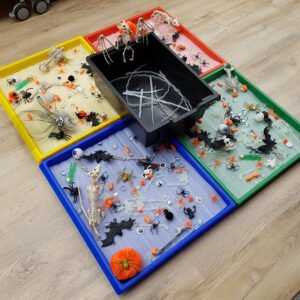

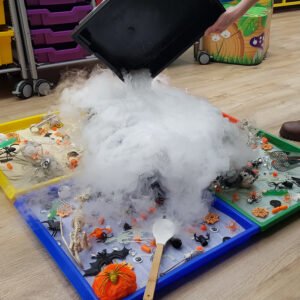
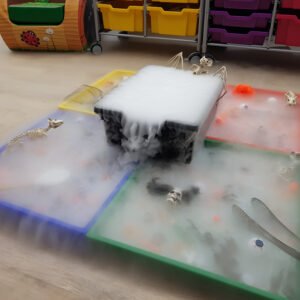
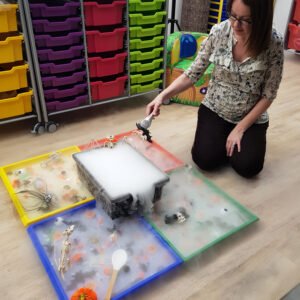
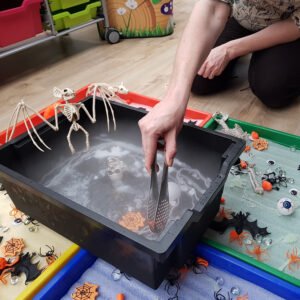
What is happening?
The History and Origins of Halloween
Halloween is a festival celebrated in several countries across the world on the 31st of October. A shortened version of All Hallows Eve or All Hallows’ Evening, Halloween is thought to have originated from an ancient Celtic festival called Samhain (Summer’s end), which celebrated the end of the harvest season in Gaelic culture. During Samhain, pagans checked their food stores and prepared for winter. Celts from Britain and Ireland celebrated the start of their new year, All Souls Day or All Hallows’ Day, on the 1st of November. This date marked the end of summer and harvest time and the start of winter. It was believed that on the 31st October the world of the living and the dead overlapped before the start of the new year. The Celts believed that on All Hallows Eve, ghosts of the dead could return and destroy the harvest and food stores. To prevent this from happening, they lit bonfires on hill tops to ward off the evil spirits and protect their winter stores. For Christians, this was the start of a three-day observance of Allhallowtide, during which the dead, saints (hallows), martys and the faithful departed were remembered. Even now, modern Christians may attend church to light candles to remember departed relatives on the 31st October.
Witches have a long history with Halloween. Old stories and superstitions tell us that All Hallows Eve would see witches gather to celebrate the day when the worlds of the living and dead overlap and the beginning of the new year. The word ‘Witch’ is derived from the word ‘Wicca’, meaning ‘Wise One’. Before the rise of Christianity, wise women, with knowledge of the healing and medicinal powers of herbs helped the sick and supported women in labour. The church felt threatened by these wise women, who often held a lot of power and respect within their communities. The (male led) church accused the women of heresy, being anti-Christian and even of devil worship. The Wiccan skills and abilities were viewed as evil sorcery, pagan worship and black magic. The general population were scared by the church’s teachings and many wise women were hunted down and accused of practicing witchcraft before being tried and sentenced to death. The wise and powerful women in the community were driven out or killed and the church continued to increase its power and influence.
History, poetry and spells often overlap. Here is a great example by William Shakespeare from Macbeth.
Double, double toil and trouble.
Double, double toil and trouble;
Fire burn and caldron bubble.
Fillet of a fenny snake,
In the caldron boil and bake;
Eye of newt and toe of frog,
Wool of bat and tongue of dog,
Adder’s fork and blind-worm’s sting,
Lizard’s leg and howlet’s wing,
For a charm of powerful trouble,
Like a hell-broth boil and bubble.
Double, double toil and trouble;
Fire burn and caldron bubble.
Cool it with a baboon’s blood,
Then the charm is firm and good.
The Dry Ice Reaction
Dry ice is a solid form of Carbon Dioxide (CO2), it is very cold, less than -70 degrees Celsius. At room temperature, it slowly sublimes (turns directly from a solid to a gas) and is visible as fog/smoke. If dry ice on its own sublimes relatively slowly. Gaseous CO2 is released on sublimation and would fill up the tray slowly, fog will eventually flow over the front lip of the tray.
Adding warm water speeds up this reaction, gas is released more rapidly, the tray fills more quickly and fog spills rapidly from the tray. Why does warm water speed up the rate of reaction? Warm water increases the amount of energy available to the reaction and causes the dry ice to sublime more quickly. What happens if you use cold water instead? This is an example of an irreversible reaction.
Other things to try…
- Does warm water or cold water result in the most spectacular reaction?
- Is it possible to colour the fog to make it even more spooky?
- If you have spare dry ice and would like to investigate it further, have a go at our exploding zip lock bags or Halloween Spooky Pumpkin What’s In My Tray activities. <hyperlink to appropriate activity pages>
- Share videos of your spooky Witch’s Cauldron demonstration on social media using #WhatsInMyTray. Can you make some spooky music to accompany your video or record your own version of double, double toil and trouble?
Health & Safety
As with all Gratnells Learning Rooms What’s In My Tray activities, you should carry out your own risk assessment prior to undertaking any of the activities or demonstrations. In particular, take care when using dry ice, consult the relevant CLEAPSS guide, wear appropriate personal protective equipment and ensure adequate ventilation to prevent unsafe build-up of CO2.

